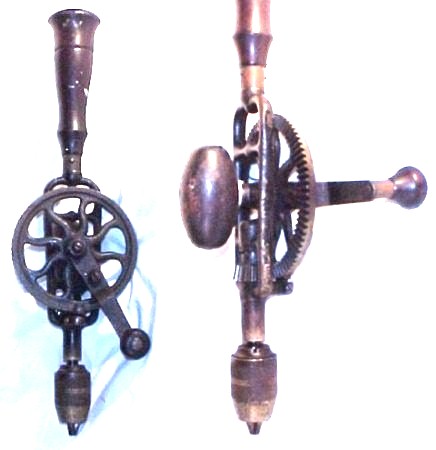Go back to Main Study Page
Type K5
 When
I started this type study, I thought that the Type K5 No.2 had emerged,
like Einstein's Theory of Relativity, nearly in its final form. However,
there were four earlier types (K1, K2, K3 and K4) that are distinguished
by a simpler mechanism for handling spindle end thrust. The Type
K5 (and all later No.2's) now has a set of tiny steel balls hidden inside
the upper bearing housing of the frame. I'm sure that other hapless owners
only discovered this when they took apart the spindle and pinion gear for
cleaning ... The Type K5 also has a new chuck design,
patented September 20, 1890, which was first introduced on the Type K4.
The chuck has three flat jaws instead of the 1877 chuck's mere two, but
the jaws are still loose & not spring-loaded in any way. The 1/4 inch
capacity of this chuck is still rather small for its size, but it theoretically
centers all round bits within its capacity. The Type K5 with its ball-bearing
spindle almost certainly came after the Type K3 and its unpatented three-jaw
chuck that mirrors the Lanfair Patent of 1895, yet the Type K5's chuck
was patented in 1890, five years prior to the Lanfair Patent. The
K4's three-jawed, springless chuck bears a "PAT APPLIED FOR"
stamp underneath the Millers Falls Co. name, and it is reeded like the
K3's never patented three-jaw spring chuck. Note the egg-shaped rosewood
side handle; its shape was borrowed from the handles of the Millers Falls
boring machine. My son's BIL owns a house in Newark, NJ, that has umpteen
doorhandles of nearly identical design, except that Richard's handles do
not have the central steel shaft to anchor the attachment screw. The Type
K4 and the earlier types K1, K2 and K3 have rather fragile main gears,
because the spoke that carries the load from the crank was only slightly
thickened to accept the attachment screw. Remember, in the earlier types
the crank was attached separately to the cross shaft on which the main
gear was also pinned, so the torque from the crank was transmitted first
to that shaft and then to the main gear, an even less efficient process
from a strength-of-materials viewpoint - the pins tended to shear off.
When
I started this type study, I thought that the Type K5 No.2 had emerged,
like Einstein's Theory of Relativity, nearly in its final form. However,
there were four earlier types (K1, K2, K3 and K4) that are distinguished
by a simpler mechanism for handling spindle end thrust. The Type
K5 (and all later No.2's) now has a set of tiny steel balls hidden inside
the upper bearing housing of the frame. I'm sure that other hapless owners
only discovered this when they took apart the spindle and pinion gear for
cleaning ... The Type K5 also has a new chuck design,
patented September 20, 1890, which was first introduced on the Type K4.
The chuck has three flat jaws instead of the 1877 chuck's mere two, but
the jaws are still loose & not spring-loaded in any way. The 1/4 inch
capacity of this chuck is still rather small for its size, but it theoretically
centers all round bits within its capacity. The Type K5 with its ball-bearing
spindle almost certainly came after the Type K3 and its unpatented three-jaw
chuck that mirrors the Lanfair Patent of 1895, yet the Type K5's chuck
was patented in 1890, five years prior to the Lanfair Patent. The
K4's three-jawed, springless chuck bears a "PAT APPLIED FOR"
stamp underneath the Millers Falls Co. name, and it is reeded like the
K3's never patented three-jaw spring chuck. Note the egg-shaped rosewood
side handle; its shape was borrowed from the handles of the Millers Falls
boring machine. My son's BIL owns a house in Newark, NJ, that has umpteen
doorhandles of nearly identical design, except that Richard's handles do
not have the central steel shaft to anchor the attachment screw. The Type
K4 and the earlier types K1, K2 and K3 have rather fragile main gears,
because the spoke that carries the load from the crank was only slightly
thickened to accept the attachment screw. Remember, in the earlier types
the crank was attached separately to the cross shaft on which the main
gear was also pinned, so the torque from the crank was transmitted first
to that shaft and then to the main gear, an even less efficient process
from a strength-of-materials viewpoint - the pins tended to shear off.